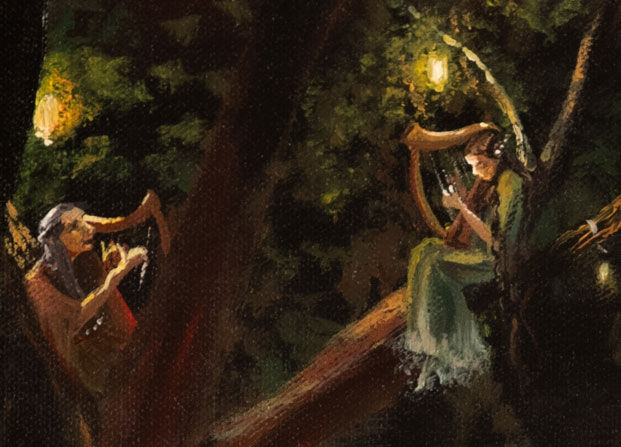Come to the Feast of the Wood-elves in Mirkwood!
- Miriam Ellis
- Nov 25, 2023
- 3 min read

What if you could enter "the perilous realm"? What if, like Bilbo in J.R.R. Tolkien's The Hobbit, you strayed from the path of a dark woodland, following the lights and music of Faërie? What might happen next?
For full immersion in this illustrated post, may I recommend putting on this enchanting harp song, "Shimmer in the Shadows" by the Irish harper, Fiachra?
Gandalf has warned Bilbo and the dwarves not to stray from the path in treacherous Mirkwood, but after many dark days of hunger and wretchedness, they cannot help but be drawn to beautiful lights glimpsed amid the trees.

Bombur has dreamt of elves feasting and his reminiscences and the famished state of the Company make following the twinkling lights almost irresistible. They can just imagine what these dream-elves might be eating and drinking.

The hobbit and dwarves creep and crawl through the wood, the scent of roasted meats drawing them on.

They come to a clearing, and there are elvish folk dressed in green and brown, seated on tree trunks, merrily feasting just as Bombur had envisioned in his dream. They are Wood-elves, sparkling with gems on their raiment and beautiful with flowers in their hair, and though they are "more dangerous and less wise" than High Elves, we still know that "that is Good People."

But every time the Company tries to step into the circle of light, all goes black, ashes fly in their faces, and they are utterly lost in the dark.

They cannot help but keep following the lights whenever they reappear, further and further from the path, and they are treated to the sight of an Elven-king, crowned with leaves, presiding over the great feast. One day, we will know he is Thranduil, father of Legolas, and leader of a fierce, astounding folk who have made their cavernous realm in perilous Mirkwood, undaunted by dreadful spiders and even worse enemies.

There are lanterns and torches and beautiful music. There is food and laughter and warmth by the fire.

But even when the dwarves push the soft-footed little hobbit into the circle of light, everything vanishes and poor Bilbo falls asleep.

All seems hopeless confusion for the wandering Company, but thankfully, the dwarves are eventually captured by the Wood-elves and taken to their kingdom. It may not seem like a mercy at the time, because Thorin's stubbornness results in Thranduil imprisoning them, but Bilbo has the Ring, and his invisibility leads to their escape. Had the elven-folk not rescued the dwarves, the travelers might have perished in Mirkwood rather than playing their part in the necessary defeat of Smaug, and Bilbo would not have brought the Ring back to Bag End — essential steps towards its eventual destruction. We have to believe it is all meant to happen in J.R.R. Tolkien's sub-created legendarium, and despite the seeming harshness of Thranduil's folk to the dwarves, it's a very good thing that their foolishness in following the lights of Faërie results in their escape from the awful forest.
But if, like me, you first heard or read The Hobbit as a child, you likely knew nothing of this bigger picture. My dear and honored father read it to me when I was about five years of age, and I was as lost as Bilbo in the enchantment of this scene which still shines out to me like golden woodland lights from that first unforgettable recital. Tolkien's inimitable imagination, borrowings from Celtic, Norse, and Old English legend, and his peerless storytelling make us hear the "horns of Elfland", see the twinkling torches, and hear the music, no matter what our age as readers. That first impression from childhood, and the great beauty of the writing, I have worked to capture in this original, hand-done painting, and I hope you have enjoyed a close-up look at its some of its details today.
